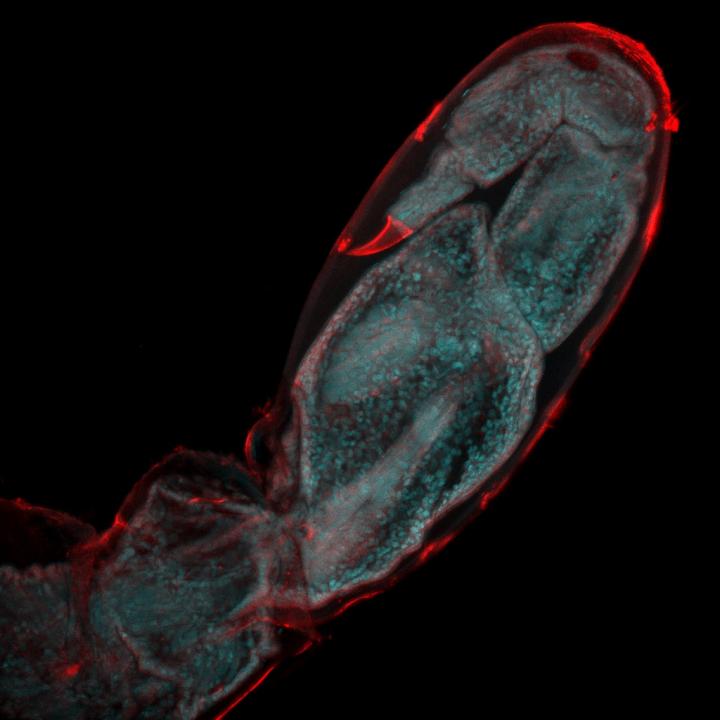

Image of a regenerating crustacean leg.
Credit: Frederike Alwes
In a study to be published in the journal eLife, the team, from the Institute of Functional Genomics in Lyon (Institut de Génomique Fonctionnelle de Lyon, IGFL), France, carried out continuous live imaging of a regenerating leg in the crustacean Parhyale hawaiensis, a close relative of the common sand hopper.
Parhyale hawaiensis was introduced in 2014 as a model for regenerative studies in a paper co-authored by Michalis Averof, Director of Research at IGFL and senior author of the current study.
“Parhyale hawaiensis is well suited for imaging limb regrowth,” Averof says. “The animals have relatively rapid limb regeneration, requiring as little as one week for young adults to fully regrow their legs. Also, their tiny limbs enable us to image the regeneration process in unprecedented cell-by-cell detail through their entire thickness.”
To record the regrowth of the Parhyale hawaiensis leg, the team used genetically engineered tools to label the limb's epidermal cells using fluorescent proteins. They then used microscopy to take continuous live recordings over the first days of regrowth, with the fluorescence in the cells allowing them to capture their individual activity.
“Using this method, we identified a specific sequence of events and cell behaviours that unfold during limb regrowth,” says first author Frederike Alwes.
“These include wound closure, followed by a quiet period when the epidermal cells migrate slowly towards the site of the wound, which then leads to extensive cell division and movement as the new leg starts to develop its shape. We were surprised to see that there was a sharp transition between the last two stages, which suggests the cells were coordinated by a common signal.”
The study also showed for the first time that there are no specialised stem cells for regenerating the epidermis in new limbs. Instead, most of the leg stump's epidermal cells divide and re-arrange, contributing to new segments in the leg.
Alwes explains: “Traditionally, insight into cell behaviour during limb regrowth has been gathered by imaging fixed samples and attempting to fill in the missing pieces, due to the difficulties in tracking cells during regeneration in active adult animals. With the ability to track the movements and behaviour of single cells individually through time, we now have the means to understand the cellular dynamics of the regeneration process, which could not have been reconstructed from fixed material.
“While our paper focuses mostly on the behaviour of epidermal cells, we now plan to extend this work to include all the different cell types that are involved in limb regrowth. The ultimate aim of our research is to explore how some animals can respond to a severe injury by regenerating an entire body part that was lost.”
###
Reference
The paper, 'Live imaging reveals the progenitors and cell dynamics of limb regeneration', can be freely accessed online at http://dx.
Media contacts
Emily Packer, eLife
e.packer@elifesciences.org
01223 855373
About eLife
eLife is a unique collaboration between the funders and practitioners of research to improve the way important research is selected, presented, and shared. eLife publishes outstanding works across the life sciences and biomedicine — from basic biological research to applied, translational, and clinical studies. All papers are selected by active scientists in the research community. Decisions and responses are agreed by the reviewers and consolidated by the Reviewing Editor into a single, clear set of instructions for authors, removing the need for laborious cycles of revision and allowing authors to publish their findings quickly. eLife is supported by the Howard Hughes Medical Institute, the Max Planck Society, and the Wellcome Trust. Learn more at elifesciences.org.












